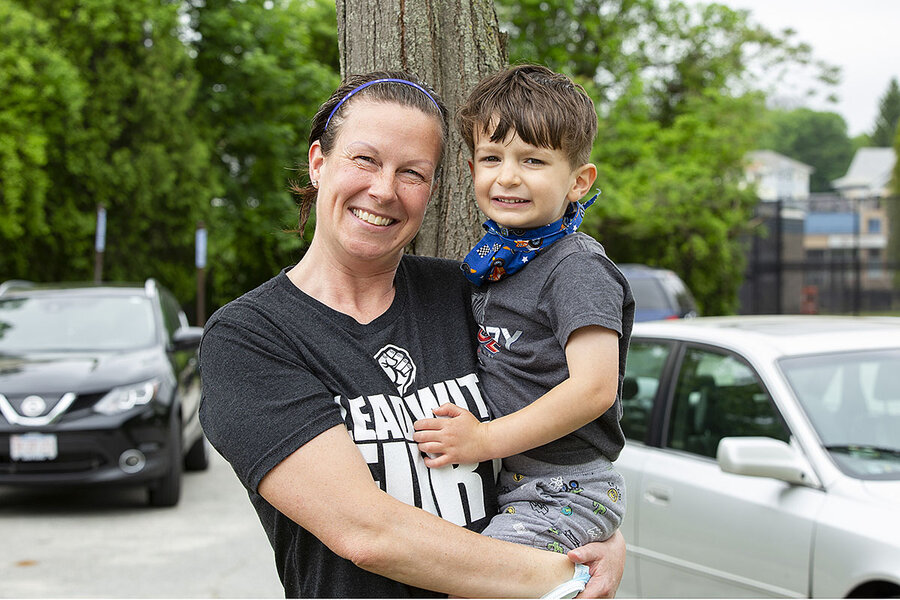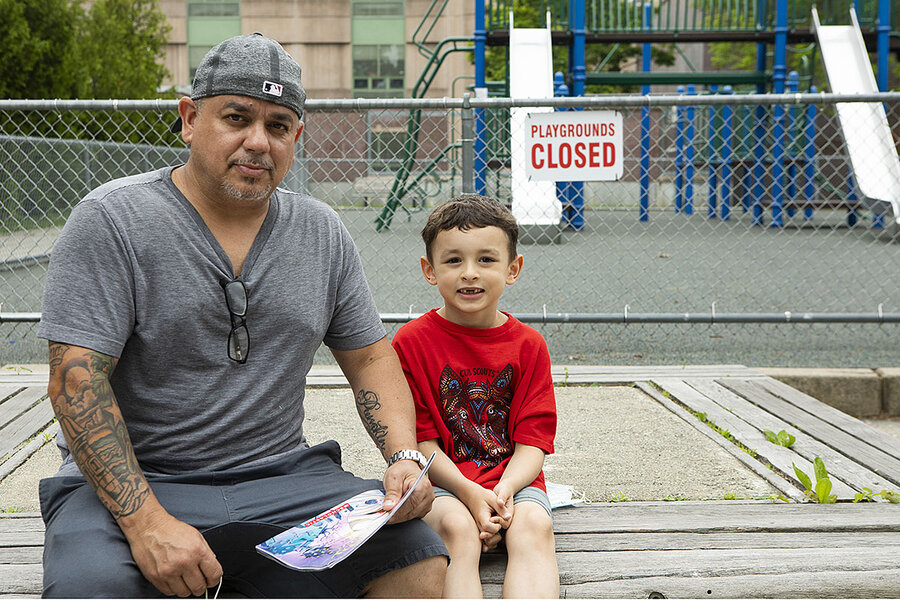Summer school 2020: Hints for how the fall will go?
Loading...
| Worcester, Mass.
Jonathan Echevarria, a single father in Worcester, Massachusetts, says it’s been a challenge to oversee schoolwork for his 6-year-old son during the pandemic, but he’s learned a lot about Jaevell and his education that he didn’t know before. He may even continue with online summer school. “I see his real potential and personality now,” this father says.
Educators in Worcester and across the United States are considering how best to use the summer to help students make up learning lost to coronavirus disruption. This year, ideas for June, July, and August – traditionally a time for helping struggling students catch up and staving off learning gaps – include using the time as a trial run for more remote and in-person learning in the fall or creating programs that blend academics with play and social-emotional support.
Why We Wrote This
After a major disruption to learning, what should summer school look like? As districts in the U.S. figure out logistics, the community in Worcester, Massachusetts, offers one approach.
Some schools will end up with few or no summer offerings, facing limited budgets and challenges reaching students. Still, educators say summer school could have a larger-than-usual impact this year, if districts are able to plan and fund it.
“The key is figuring out what each student needs,” says Douglas Harris, a professor at Tulane University, “and getting them what they need to get back on track.”
Amanda Sonnenberg feels exhausted from overseeing the remote learning of her four kids. As the school year draws to a close, she’s looking forward to a break and outside play. But, for the first time, she’s also considering summer school for her children.
“Summer is summer,” she says, as she wears a color-coordinated mask and Red Sox T-shirt in line outside Gates Lane School of International Studies to pick up meals distributed by Worcester Public Schools. “But given the circumstances that we just had COVID-19 ... I would consider [summer school] just to help them be prepared for next year.”
Educators here, in New England’s second-largest city, and across the United States are considering how best to use the summer to help students make up for lost learning after the most disruptive spring for K-12 education in recent history. This year, ideas for June, July, and August – traditionally a time for helping struggling students catch up and staving off learning gaps – include using the time as a trial run for more remote and in-person learning in the fall or creating programs that blend academics with play and social-emotional support.
Why We Wrote This
After a major disruption to learning, what should summer school look like? As districts in the U.S. figure out logistics, the community in Worcester, Massachusetts, offers one approach.
Editor’s note: As a public service, all our coronavirus coverage is free. No paywall.
Some schools will end up with few or no summer offerings, facing limited budgets and challenges reaching students. Still, educators say summer school could have a larger-than-usual impact this year, if districts are able to plan and fund it.
“To the extent that [summer school] can be done well and in ways that could reach students who’ve been missed previously by remote learning, it would be huge,” says Kathryn McDermott, an education policy professor at the University of Massachusetts Amherst. She notes that, based on studies of previous disruptions of schooling, such as during natural disasters, student learning loss this year has likely been high for many.
“The sooner that it’s possible to start getting some of that time back for them, the better,” Professor McDermott says.
Determining the best approach
It’s difficult to measure the amount of learning loss students have experienced from COVID-19 shutdowns because most end-of-year assessments were canceled. A preliminary study by researchers at NWEA, a nonprofit in Portland, Oregon, that designs student assessments, suggests that students nationwide will start school in the fall with roughly 70% of the learning gains normally made in reading during a typical school year and with less than 50% of learning gains in math.
Educators also worry that “summer slide” will be greater this year– especially for less-affluent students who, without access to summer enrichment programs, fall behind their peers.
The Center on Reinventing Public Education recently analyzed summer school plans for 100 public school districts across the U.S. and found uneven programming, with 61% of those districts offering summer school.
What is offered this summer should be based on student needs, which will vary by how much support schools and families could provide this spring, says Douglas Harris, a professor at Tulane University in New Orleans who researches the economics of education.
“The idea of the achievement gap widening in this scenario is most certainly the case,” he says. “The key is figuring out what each student needs and getting them what they need to get back on track.”
Summer can also offer other opportunities, say educators. While internet access offers challenges, online learning can open the door to more options and include “community-based expertise,” writes Thomas Del Prete, director of the Adam Institute for Urban Teaching and School Practice at Clark University in Worcester, in an email to the Monitor.
“We have an opportunity to reimagine and broaden our thinking on what learning can look like in the summer (and beyond) and who can participate. We might start this summer by thinking how to create opportunities for learning for a broader range of students, not just for purposes of remedial learning, for some form of enrichment, or to get a head start on reading for the school year,” he writes.
He suggests activities curated by teachers including online bookclubs and museum tours, and online or phone interviews for oral history projects.
In Los Angeles, summer school is open for the first time to all students online, and the Los Angeles Unified School District is pairing with film studios and sports teams for enrichment classes. Elsewhere, in Illinois, the governor signed an executive order allowing in-person summer school. Massachusetts Education Commissioner Jeffrey Riley released guidance last week allowing in-person instruction for groups of 10 students or fewer. The guidelines also said remote learning might be the “most feasible and safest” option for many districts.
One example: Worcester
In Worcester, all summer school will be conducted online, and community groups are eager to form partnerships to enhance programming. But detailed summer school plans have been slow to develop and there are concerns from the community and educators about being able to reach students who most need help.
“There’s an opportunity to transform the way we do the business of teaching and learning in this moment,” starting with summer school, says Jennifer Davis Carey, executive director of the Worcester Education Collaborative, a nonprofit community group in the city of about 186,000 people. “We have to make sure we capture that opportunity.”
Located about an hour west of Boston and home to a dozen colleges, several museums, and spacious parks, Worcester has experienced rapid growth in the past few years. The city’s school district, with about 25,000 pupils, has higher rates of economically disadvantaged students and students of color than the state average. The district has earned some accolades, including former President Barack Obama calling Worcester Technical High School a model for the nation.
Maureen Binienda, superintendent of Worcester Public Schools, says the district plans to expand summer school to all students in grades 2 through 6 for the first time. The district will also offer its typical programs for middle and high school credit recovery, English language learners, and special education students. Most Worcester summer school programs will begin on June 17, five days after the school year ends.
Ms. Binienda says she’s hoping that the number of kids participating in summer school will increase this year with the expanded elementary school programs, but “we’ll wait to see if parents are exhausted.” She says the district doesn’t know the format yet of fall reopening, but summer school could help if it includes remote elements. “The more you do online learning, the better you get.”
On a recent morning, Jose Lehardy and his step-grandson pause outside Gates Lane to pick up a meal and talk about school. They say they’re interested in more summer activities from the school. Mr. Lehardy praises remote learning so far for keeping his 7-year-old grandson Ryan headed in the “right direction.” The second grader says he likes writing a letter to his teacher every day and practicing spelling.
Ms. Carey, of the Worcester Education Collaborative, says she’s working closely with community groups and cultural organizations such as the Boys & Girls Club, the Worcester Art Museum, and EcoTarium, a local children’s science museum, to create modules for students to complement their schooling this summer and throughout the year.
“We have to come together as a community and essentially create learning [opportunities] anytime, anyplace,” she says.
A key challenge for Worcester Public Schools, like other districts around the U.S., is lack of internet connectivity and technology access for students. The district has distributed 1,400 Chromebooks, giving all families one laptop for every two children. Superintendent Binienda says the district is 6,000 laptops away from its goal of one device for every student, and plans to spend some of the funds it receives from the federal CARES Act on Chromebooks and internet hot spots. The district was still distributing laptops to students in late May, and families can keep them for the summer.
With the switch to remote learning has come a higher level of parent involvement with the education of students, says Ms. Binienda, who hopes that continues this summer and beyond.
That may be the case for Jonathan Echevarria, a single father in Worcester. He says it’s been a challenge to oversee schoolwork, but he’s learned a lot about his son Jaevell and his kindergarten education that he didn’t know before. He may even continue with a special online summer school program offered for younger students.
“I see his real potential and personality now,” Mr. Echevarria says.
Editor’s note: As a public service, all our coronavirus coverage is free. No paywall.











